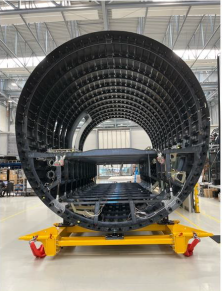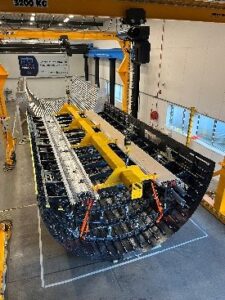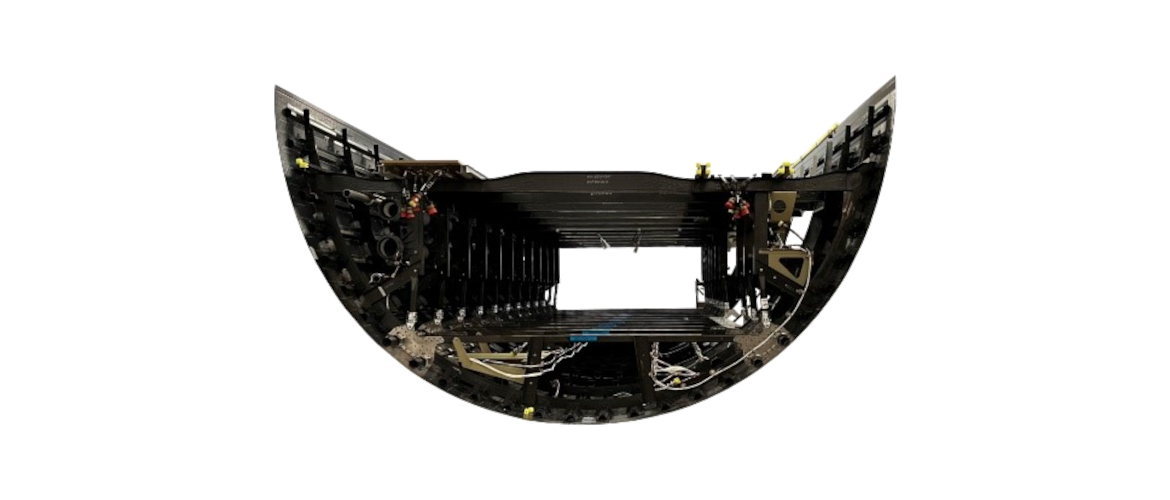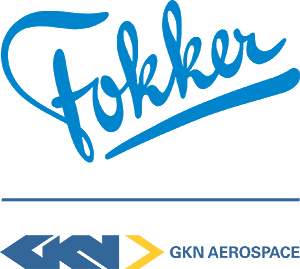Clean sky 2 funded project STUNNING, SmarT mUlti-fuNctioNal and INtegrated TP fuselaGe, has developed a fully equipped lower half typical fuselage (A321) out of thermoplastic composites. The project is part of the Clean Sky 2 – Large Passenger Aircraft –Platform 2 development stream, led by Airbus. The project itself received over 11.6M€ funding, with an additional support through CfPs worth over 6M€ funding.
Objectives
 The objective of Large Passenger Aircraft (LPA) Platform 2 – Multifunctional Fuselage Demonstrator (MFFD) is to validate high potential combinations of airframe structures, cabin/cargo, and system elements using advanced materials and applying innovative design principles in combination with the most advanced system architecture in combination with the next generation cabin.
The objective of Large Passenger Aircraft (LPA) Platform 2 – Multifunctional Fuselage Demonstrator (MFFD) is to validate high potential combinations of airframe structures, cabin/cargo, and system elements using advanced materials and applying innovative design principles in combination with the most advanced system architecture in combination with the next generation cabin.
The overall objectives of the MFFD were achieved with the completion of its assembly in Spring 2024:
- Enable a high production rate up to 100 aircraft per month
- Achieve a total fuselage weight reduction of at least 1000kg
- Competitive recurring costs
Lower half of the Multifunctional Fuselage Demonstrator
 In 2017, project activities started on the development of the lower half of the MFFD. This part of the project has developed, manufactured and delivered a 180° full scale multi-functional integrated thermoplastic lower fuselage shell, incl. cabin and cargo floor structure and relevant main interior and system elements. The demonstrator has a length of 8m, and a varying radius between 2 and 2.5m, similar to an A321 lower fuselage half. The demonstrator was ready end of 2022.
In 2017, project activities started on the development of the lower half of the MFFD. This part of the project has developed, manufactured and delivered a 180° full scale multi-functional integrated thermoplastic lower fuselage shell, incl. cabin and cargo floor structure and relevant main interior and system elements. The demonstrator has a length of 8m, and a varying radius between 2 and 2.5m, similar to an A321 lower fuselage half. The demonstrator was ready end of 2022.
The STUNNING consortium
The STUNNING consortium consists of GKN Fokker, Diehl, NLR and TUDelft. GKN Fokker was responsible for management and overall technical leadership of the program. Furthermore, GKN Fokker brought its knowledge on thermoplastics manufacturing of parts, welding and advanced assembly techniques to the consortium. In addition, GKN Fokker Elmo was responsible for advanced systems development within the consortium. Diehl was responsible for interior parts such as sidewall panels, monument interfaces and smart system multiports. NLR was responsible for the automated fibre placement based manufacturing of the large skin as a single piece. In addition, NLR carried out related applied research on, for example, induction welding, crack arrest, additive manufacturing, fast non-destructive inspection, and wireless data transfer. The TUDelft brought its expertise on ultrasonic welding for clip-to-skin and frame-to-clip robotic welding in the lower half of the MFFD and addressed some fundamental research topics with the support of several PhD candidates. The sub assembly of the lower shell took place at SAM XL (TU Delft manufacturing automation expertise centre).
Main publications and communications about STUNNING
Lower half manufacturing, including movies:
Veldman S.L, Kortbeek P.J, Wölcken P.C, Herrmann R, Kos J, Fernandez Villegas I. Development of a multifunctional fuselage demonstrator. Proc. Aerospace Europe Conference, Bordeaux, France, paper 481, 2020.
Kos, J. Manufacturing of MFFD’s lower fuselage skin: World’s largest thermoplastics aerospace part, San Diego, USA, & online, Jan 3rd-7th 2022.
Movie: MFFD/STUNNING: Automated Fibre Placement based manufacturing of the lower half of the skin, NLR media, 2024,
Movie: MFFD/STUNNING: Automated Pick and Place of Stringers in the lower shell, SAM XL, 2023,
Movie: MFFD/STUNNING: Frame integration through Ultrasonic Spot Welding in the lower shell demonstrator, SAM XL 2024.
Supporting technologies:
De Kruijk J.C, Sterk S, De Wit A.J and Van Hoorn, N. Assembly of thermoplastic fuselage structures by induction welding of unidirectional carbon fiber composites, Proc. AIAA SciTech Forum, Orlando, Florida, USA, paper AIAA 2024-1090, 2024,
Tijs B. H. A. H., Analysis of thermoplastic composites and conduction welded joints, Ph.D. thesis, Delft University of Technology, Delft, the Netherlands (5 2023).
Van Dooren K., Bisagni C., Design, analysis and testing of thermoplastic welded stiffened panels to investigate skin-stringer separation in post-buckling, Composites Part B: Engineering 267 (2023) 111033.
Tijs B. H. A. H., Doldersum M. H. J., Turon A., Waleson J. E. A., Bisagni C., Experimental and numerical evaluation of conduction welded thermoplastic composite joints, Composite Structures 281 (2022) 114964.
Brito C.B.G., Teuwen J., Dransfeld C.A., Villegas I.F. The effects of misaligned adherends on static ultrasonic welding of thermoplastic composites. Composites Part A 2022: Applied Science and Manufacturing,
Koenis T.P.A, Van den Brink, W.M, Bosman, M Full process chain simulation of the (wire-based) laser metal deposition process towards fatigue life prediction, Procedia Structural Integrity, Vol 34, pages 235-246, 2021,
Nardi D., Sinke J. Design analysis for thermoforming of thermoplastic composites: prediction and machine learning-based optimization. Composites Part C 2021: Open Access 5 (2021) 100126
Van den Brink W.M, Vankan W.J, De Kruijk J, Veldman, S.L, Herrmann R, Multifunctional Fuselage Demonstrator: Thermoplastic Composite Skin Manufacturing Developments, II European Conference On Multifunctional Structures (EMuS 2020), 2020,
This project has received funding from the European Union’s Clean Sky 2 Innovation Action programme under grant agreement No 776455






